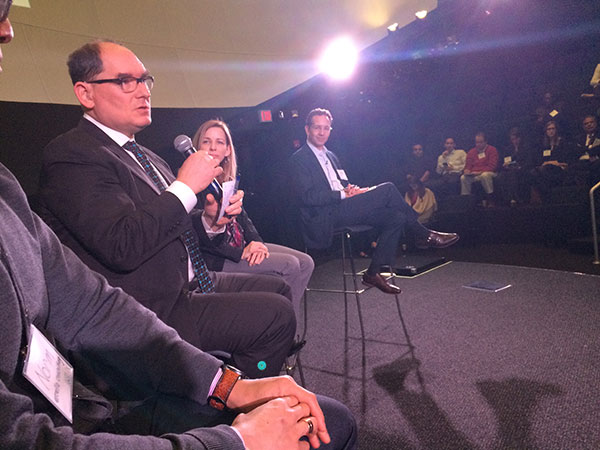GoodGovUX Addresses UX of IT Contracts

That was the question posed to more than 100 people at the GoodGovUX event at the Artisphere in Arlington, Virginia, on February 24th. Attendees learned how government can improve the user experience of digital products, from intranets to forms to good ol’ fashioned websites.
GoodGovUX co-founder Keith Deaven collected responses from the crowd, which was a diverse mix of people working in private industry, federal, and local governments. Definitions of user experience ranged from the technical (“it’s the functional design before the visual design”), to the practical (“I got started in UX so my mom could use the computer”).
It was clear that you could walk through a crowd of UX professionals and get a different answer from everyone you talked to, highlighting a fundamental problem with UX in government: how can we incorporate user experience design into IT contracts and proposals? And how can we make sure whatever website or mobile app that gets created is ultimately usable and valuable to customers?
The goal of the event was to bring together professionals from across government and contracting communities to improve customer experience by developing a common understanding of what UX is, and why it matters for government projects.
How to improve UX in government
Civic designer Dana Chisnell (@danachis) from the U.S. Digital Service observed how coming into government can feel like a timewarp to 2005, but noted that there is currently an amazing opportunity for design to “be a beacon that can pull government to the here and now.” The crowd was further inspired by stories from her field research about employees in public service who designed solutions to problems they faced every day that let to better solutions.
“Everybody is a designer,” she noted. “Everyone who works in government will be the next generation of civic designers driving the next enlightenment.”
The U.S. Digital Services Playbook was cited as a great place for people to get started with UX.

A panel of public servants and IT contractors delved into the quickest ways to improve digital products. Low-fidelity observation and guerilla hallway-style testing were some initial suggestions from Chisnell and Jonathan Rubin (@jonathan_rubin), UX Program Manager for DigitalGov.
Robert Read (@robertleeread), Co-Founder of 18F at GSA, stressed the importance of being able to act on feedback gathered, as well as getting developers into the rooms with users. Overall, there was a recurring theme: for those seeking to improve user experience, look for quick wins and small successes that can be built on.
Establishing UX in an organization can be very challenging, with concerns related to overcoming organizational silos and demonstrating the value to senior leadership. Read pointed out that the solicitation process can make projects non-agile, and suggested a major shift in writing solicitations so that developing an agile team becomes a key deliverable. Chisnell discussed how the U.S. Digital Service is creating a library of RFPs that can help others in crafting their own proposals for digital services. Moderator John Whalen (@johnwhalen), president of the UXPA DC Chapter, emphasized the importance of finding everyone you can and making sure they are actively involved in a project across organizations to break down silos.
Get involved and volunteer
If you’d like to help drive the next enlightenment in civic design, go to the GoodGovUX website, sign up for updates, or even join a team and volunteer.
Volunteers are needed in 3 key areas:
- Terminology and Definitions – Defining User Experience terms for any audience
- RFPs and Proposal Language – Crafting or finding examples of good contracting language
- Deliverables and Best Practices – Creating tools and guidance to help people build UX into contracts
You can also follow the group on Twitter at @GoodGovUX.
Jordan Higgins is a Web and Social Media Manager at the Defense Intelligence Agency.

